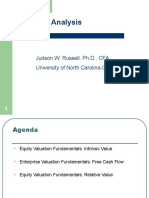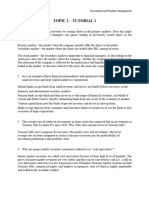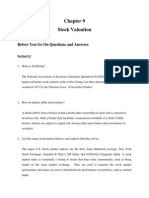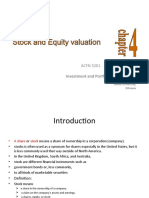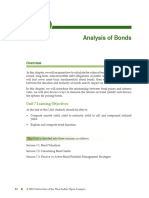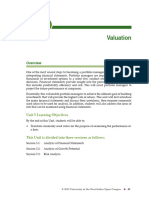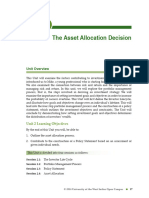FINA2004 Unit 6
Uploaded by
Taedia HibbertFINA2004 Unit 6
Uploaded by
Taedia HibbertU U N IT
6
Analysis of Common Stock
Overview
Now that we know how to analyze company performance and growth potential from
financial analysis, we can now estimate the value of the firm’s stock. The purpose of
this analysis is to determine which stock should be added to a portfolio. The basic rule
to this analysis is to purchase when the stock is worth more than the current stock
price, and sell when if the price is higher than the value of the stock.
In this chapter, we will explore the Dividend discount model, which is one approach to
stock analysis. This will calculate the price of the stock, for the purpose of comparing
it to the market price. We will then be introduced to the different stock markets across
the financial industry, and finally analyze the approaches to equity acquisition in
portfolio management.
Unit 6 Learning Objectives
By the end of this Unit, students will be able to:
1. Assess a Discounted Cash Flow
2. Compare passive and active equity management strategies
This Unit is divided into three sessions as follows:
Session 6.1: Stock Valuation
Session 6.2: The Stock Market
Session 6.3: Passive vs Active Equity Portfolio Management Strategies
Video
Watch this introductory video: Accounting for Investments in Common Stock:
https://www.youtube.com/watch?v=8Oy5U0BSYo8&feature=youtu.be
73 © 2015 University of the West Indies Open Campus
Readings and Resources
Required Reading
Hall, R. A. (2011). Corporate Valuation and Takeover. bookboon.com.
http://bookboon.com/en/corporate-valuation-and-takeover-ebook
74 FINA2004 Portfolio Management – UNIT 6
SSession 6.1
Company Analysis and Stock Valuation
Introduction
Common stockholders are the owners of the firm, they elect the firm’s board of directors,
who in turn appoint the firm’s top management team. Common stockholders have the
right to the firm’s income that remains after bondholders and preferred stockholders
have been paid. The potential cash flow from investment in common stock is the
dividend payments and the revenue from the sale of stock.
Session Objectives
By the end of this session, you will be able to:
• Explain how investors use stock valuation models
• Examine a Dividend Discount Model
Procedure for valuing common stock
Three-Step Procedure for Valuing Common Stock
1. Estimate the amount and timing of future cash flows the common stock is expected
to provide.
2. Evaluate the riskiness of the future dividends, and determine the rate of return
an investor might expect to receive from a comparable risky investment, which
becomes the investor’s required rate of return.
3. Calculate the present value of the expected dividends by discounting them back to
the present at the investor’s required rate of return.
Value of Common stock = Present Value of future cash flows = Present Value of
(dividend + expected selling price)
Example:
Consider valuing a share of common stock that we plan to hold for only one year.
What will be the value of the stock today if it pays a dividend of $5.00, is expected to
have a price of $70 and the investor’s required rate of return is 15%?
75 FINA2004 Portfolio Management – UNIT 6
Timeline for One-Year Investor
Value of common stock = ($5+$70) ÷(1+0.15)
=$75÷1.15
=$65.22
– If the current stock price were less than this amount, expect investors to rush in
and buy it, driving up the stock’s price.
– If the stock price exceeded this amount, selling it would cause the stock price to
quickly fall.
This is known as the Dividend Discount Model.
This model can be applied to equity investments held for any number of years.
Div1
P0 = +
Div2 L +
+
DivN
+
PN
1 + rE 2
(1 + rE ) (1 + rE ) N (1 + rE ) N
The price of the stock is equal to the discounted value of the future cash flows.
There are three variables that drive share value:
• The most recent dividend: The more, the higher.
• Expected rate of growth in future dividends: The higher, the higher.
• Investor’s required rate of return : The higher, the lower.
Thus, the value of a stock price under constant growth can be calculated as follows:
where: P0 = Div1 rE = Div1
+g
rE - g P0
76 FINA2004 Portfolio Management – UNIT 6
We cannot use the constant dividend growth model to value a stock if the growth rate
is not constant. However, we can use the general form of the model to value a firm
by applying the constant growth model to calculate the future share price of the stock
once the expected growth rate stabilizes.
PN = DivN + 1
rE - g
This video walks through the Dividend Discount Model
https://www.youtube.com/watch?v=TlH3_iOHX3s
ACTIVITY 6.1
Exercise:
1. The P/E ratio of a normal-growth firm is 10. The dividend is DPS1 =
$10, and the stock price is $20. What is the growth rate (g)?
2. The Sugar Corporation’s dividends have been growing at 6% per year
for the past 15 years. The firm currently pays an annual dividend of
$5 per share. Determine the current value of a share of the firm’s
common stock to investors with the following required rates of return:
a. 12% b. 14% c. 6% d. 4%
Session Summary
The Dividend Discount Model is one of several methods that can be applied to
determine the price of a stock. As a portfolio manager, it is more important to identify
what makes the stock price move, and how to calculate the growth prospects of the
value of a share.
77 FINA2004 Portfolio Management – UNIT 6
SSession 6.2
The Stock Market
Introduction
New securities trade in the primary market while currently outstanding securities
trade in the secondary market. The corporation receives money from the sale of its
securities only in the primary market.
There are two types of secondary markets:
1. Organized exchanges where trading occurs at a physical location; and
2. Over-the-counter market where trading occurs over the telephone or through
computer networks.
Session Objectives
By the end of this session, you will be able to:
• Describe basic stock market transactions
• Explain the two types of secondary markets
Organized Exchanges
The New York Stock Exchange (NYSE), also called the “Big Board”, is the oldest of all
organized exchanges and the largest organized exchange in the world. While the NYSE
is considered an organized exchange because of its physical location, the majority of
its trades are done electronically without a face-to-face meeting of traders.
To be listed on the NYSE, a firm must meet strict requirements dealing with profitability
and market value, and be widely owned.
Much of the trading on the NYSE is made up of block trades i.e. transactions involving
10,000 shares or more by a single individual or institution.
The American Stock Exchange (AMEX) is the nation’s second largest, floor-based
exchange. However, in terms of volume, the AMEX is a distant number two with less
than 5% of that on the NYSE.
AMEX merged with NASDAQ in 1998 but continues to operate as a separate entity.
78 FINA2004 Portfolio Management – UNIT 6
Over-the-Counter (OTC) Market
The over-the-counter market is made up of a network of dealers that has no listing
or membership requirements. Today, the OTC market is electronic; Nasdaq leads the
way.
OTC listings generally include companies too new or too small to be eligible for listing
on a major exchange.
Nasdaq debuted in 1971 and is the world’s first electronic stock market.
While Nasdaq lists more companies than the NYSE, they are relatively smaller
companies (with a few exceptions).
There are about 1,000 market participants, trading firms that are linked electronically,
with price and trading information broadcast to over 350,000 terminals worldwide.
The Nasdaq stock market has two tiers of listed companies:
• Nasdaq National Markets, made up of around 4,000 companies like Dell (D), Intel
(INTC); and
• Nasdaq Smallcap Market, which includes over 1,000 smaller emerging growth
companies.
For more on Understanding the Stock Market view the following video resource:
https://www.youtube.com/watch?v=HuLIqNKwnZc
Session Summary
This session builds on our introduction to the stock market in Unit 1. Now that we
know how to determine stock value, we can apply this to making investment decisions
in equity securities.
79 FINA2004 Portfolio Management – UNIT 6
SSession 6.3
Passive vs Active Equity Portfolio
Management Strategies
Introduction
Determining an investment style is useful in measuring performance relative to a
benchmark. The style identification allows an investor to diversify by portfolio and
allows control of the total portfolio to be shared between the investment managers
and a sponsor.
An individual with a passive approach invests in securities for the long term, while the
the person with an active approach seeks to take advantage of market inefficiencies.
Session Objectives
By the end of this session, you will be able to:
• Describe the two generic equity portfolio management styles
• Explain the techniques for constructing an equity portfolio
Passive versus Active Management
Passive equity portfolio management
• Long-term buy-and-hold strategy
• Usually tracks an index over time
• Designed to match market performance
• Manager is judged on how well they track the target index
Active equity portfolio management
– Attempts to outperform a passive benchmark portfolio on a risk-adjusted basis
by seeking the “alpha” value
An Overview of Passive Strategies
• Attempt to replicate the performance of an index
– May slightly underperform the target index due to fees and commissions
80 FINA2004 Portfolio Management – UNIT 6
• Strong rationale for this approach
– Costs of active management (1 to 2 per cent) are hard to overcome in risk-
adjusted performance
• Many different market indexes are used for tracking portfolios
– S&P 500 Index
– NASDAQ Composite Index
Index Portfolio Construction Techniques
• Full Replication
– All securities in the index are purchased in proportion to weights in the index
– This helps ensure close tracking
– Increases transaction costs, particularly with dividend reinvestment
• Sampling
– Buys a representative sample of stocks in the benchmark index according to
their weights in the index
– Fewer stocks means lower commissions
– Reinvestment of dividends is less difficult
– Will not track the index as closely, so there will be some tracking error
• Quadratic Optimization (or programming techniques)
– Historical information on price changes and correlations between securities are
input into a computer program that determines the composition of a portfolio
that will minimize tracking error with the benchmark
– This relies on historical correlations, which may change over time, leading to
failure to track the index
Methods of Index Portfolio Investing
• Index Funds
– In an indexed portfolio, the fund manager will typically attempt to replicate
the composition of the particular index exactly
– The fund manager will buy the exact securities comprising the index in their
exact weights
– Change those positions anytime the composition of the index itself is changed
– Low trading and management expense ratios
81 FINA2004 Portfolio Management – UNIT 6
– The advantage of index mutual funds is that they provide an inexpensive way
for investors to acquire a diversified portfolio
• Exchange-Traded Funds (ETF)
– EFTs are depository receipts that give investors a pro rata claim on the capital
gains and cash flows of the securities that are held in deposit by a financial
institution that issued the certificates
– A significant advantage of ETFs over index mutual funds is that they can be
bought and sold (and short sold) like common stock
– The notable example of ETFs
‧ Standard & Poor’s 500 Depository Receipts (SPDRs)
‧ iShares
‧ Sector ETFs
An Overview of Active Strategies
• The goal is to earn a portfolio return that exceeds the return of a passive benchmark
portfolio, net of transaction costs, on a risk-adjusted basis
– Need to select an appropriate benchmark
• Practical difficulties of the active manager
– Transactions costs must be offset by superior performance vis-à-vis the
benchmark
– Higher risk-taking can also increase needed performance to beat the benchmark
Fundamental Strategies
• Top-Down versus Bottom-Up Approaches
– Top-Down
‧ Broad country and asset class allocations
‧ Sector allocation decisions
‧ Individual securities selection
– Bottom-Up
‧ Emphasizes the selection of securities without any initial market or sector
analysis
‧ Form a portfolio of equities that can be purchased at a substantial discount
to what his or her valuation model indicates they are worth
82 FINA2004 Portfolio Management – UNIT 6
• Three Generic Themes
– Time the equity market by shifting funds into and out of stocks, bonds, and
T-bills depending on broad market forecasts
– Shift funds among different equity sectors and industries (e.g., financial
stocks, technology stocks) or among investment styles (e.g., value, growth
large capitalization, small capitalization). This is basically the sector rotation
strategy
– Do stock picking and look at individual issues in an attempt to find undervalued
stocks
• The 130/30 Strategy
– Long positions up to 130 per cent of the portfolio’s original capital and short
positions up to 30 per cent
– The use of the short positions creates the leverage needed, increasing both risk
and expected returns compared to the fund’s benchmark
– Enables managers to make full use of their fundamental research to buy stocks
they identify as undervalued as well as short those that are overvalued
Technical Strategies
• Contrarian Investment Strategy
– The belief that the best time to buy (sell) a stock is when the majority of other
investors are the most bearish (bullish) about it
– The concept of mean reverting
– The overreaction hypothesis
• Price Momentum Strategy
– Focus on the trend of past prices alone and make purchase and sale decisions
accordingly
– Assume that recent trends in past prices will continue
Anomalies and Attributes
• Earnings Momentum Strategy
– Momentum is measured by the difference of actual EPS to the expected EPS
– Purchases stocks that have accelerating earnings and sells (or short sells) stocks
with disappointing earnings
83 FINA2004 Portfolio Management – UNIT 6
• Calendar-Related Anomalies
– The Weekend Effect
– The January Effect
• Firm-Specific Attributes
– Firm Size
– P/E and P/BV ratios
Active vs Passive Portfolio Management:
h t t p : / / w w w. a i c p a . o r g / i n t e r e s t a r e a s / p e r s o n a l f i n a n c i a l p l a n n i n g /
resources/practicecenter/forefieldadvisor/downloadabledocuments/
ffactiveversuspassiveconceptpiece.pdf
ACTIVITY 6.2
Read the following debate on equity portfolio management strategies:
http://www.forbes.com/sites/investor/2013/01/31/finally-an-answer-to-
the-active-versus-passive-strategy-debate/
Do you agree with this view? Why?
Unit 6 Summary
Unit 6 has provided students with the information needed to make equity investments.
The following units will teach students how to assess the value of bonds.
84 FINA2004 Portfolio Management – UNIT 6
References
Education Unlocked. (2013, December 19). Dividend Discount Model (DDM) [Video
file]. Retrieved from https://www.youtube.com/watch?v=TlH3_iOHX3s
Hall, R. A. (2011). Corporate Valuation and Takeover. bookboon.com.
http://bookboon.com/en/corporate-valuation-and-takeover-ebook
Riley, Alison. (2012, May 30). Accounting for Investments in Common Stock. [Video
file]. Retrieved from
https://www.youtube.com/watch?v=8Oy5U0BSYo8&feature=youtu.be
Stanford Graduate School of Business. (2013, October 7). Understanding the Stock
Market: Stocks and Bonds online course preview [Video File]. Retrieved from
https://www.youtube.com/watch?v=HuLIqNKwnZc
85 FINA2004 Portfolio Management – UNIT 6
You might also like
- Valuation Analysis: Judson W. Russell, PH.D., CFA University of North Carolina-CharlotteNo ratings yetValuation Analysis: Judson W. Russell, PH.D., CFA University of North Carolina-Charlotte86 pages
- University of Aberdeen: Alternative Assessment Test For The Degree of MANo ratings yetUniversity of Aberdeen: Alternative Assessment Test For The Degree of MA9 pages
- Essentials of Corporate Finance 1st Edition Parrino Solutions Manualdownload100% (3)Essentials of Corporate Finance 1st Edition Parrino Solutions Manualdownload52 pages
- The Role of The Financial Manager: (Topic 1)No ratings yetThe Role of The Financial Manager: (Topic 1)19 pages
- Stock Valuation: Stock Features and Valuation Components of Required ReturnNo ratings yetStock Valuation: Stock Features and Valuation Components of Required Return24 pages
- Valuing Stocks: Answers To Concept Review QuestionsNo ratings yetValuing Stocks: Answers To Concept Review Questions4 pages
- What is the Intrinsic Value of a Stock and How to Calculate It - Blog by TickertapeNo ratings yetWhat is the Intrinsic Value of a Stock and How to Calculate It - Blog by Tickertape1 page
- Capital Market and Portfolio ManagementNo ratings yetCapital Market and Portfolio Management11 pages
- Investment Analysis and Portfolio Management: Lecture Presentation SoftwareNo ratings yetInvestment Analysis and Portfolio Management: Lecture Presentation Software118 pages
- Submitted To: Prof Edwin Prepared: Ankit Dokania (09PG422)No ratings yetSubmitted To: Prof Edwin Prepared: Ankit Dokania (09PG422)28 pages
- A Basic Understanding of Financial InstrumentsNo ratings yetA Basic Understanding of Financial Instruments25 pages
- Equity Valuation: Why Determine Value of A StockNo ratings yetEquity Valuation: Why Determine Value of A Stock12 pages
- Interpretation of Accounts.: Analysis of Financial Statements Ratio Analysis Cash Flow Statement FRS-1No ratings yetInterpretation of Accounts.: Analysis of Financial Statements Ratio Analysis Cash Flow Statement FRS-17 pages
- Fidelia Agatha - 2106715765 - Summary&Problem MK - Pertemuan Ke 7No ratings yetFidelia Agatha - 2106715765 - Summary&Problem MK - Pertemuan Ke 720 pages
- L2 Financial Statements Analysis and Interpretation P2No ratings yetL2 Financial Statements Analysis and Interpretation P229 pages
- Equity Research Interview Questions and AnswersNo ratings yetEquity Research Interview Questions and Answers22 pages
- Week 4 5 Ulob - Working Capital ManagementNo ratings yetWeek 4 5 Ulob - Working Capital Management7 pages
- Selection of Stocks Fundamental and Technical AnalysisNo ratings yetSelection of Stocks Fundamental and Technical Analysis52 pages
- Project Report Risk and Returns of SecuritiesNo ratings yetProject Report Risk and Returns of Securities89 pages
- C11 An Introduction To Security ValuationNo ratings yetC11 An Introduction To Security Valuation37 pages
- Investment Analysis and Portfolio Management: Frank K. Reilly & Keith C. Brown100% (1)Investment Analysis and Portfolio Management: Frank K. Reilly & Keith C. Brown122 pages
- Investment and Portfolio Management: ACFN 3201No ratings yetInvestment and Portfolio Management: ACFN 320116 pages
- Security Analysis and Portfolio ManagementNo ratings yetSecurity Analysis and Portfolio Management61 pages
- Real Estate Finance and Investment - Lecture Notes100% (1)Real Estate Finance and Investment - Lecture Notes2 pages
- Chapter 7 - Value of Real Options - LatestNo ratings yetChapter 7 - Value of Real Options - Latest31 pages
- Dividend Discount Model (DDM) : A Study Based On Select Companies From IndiaNo ratings yetDividend Discount Model (DDM) : A Study Based On Select Companies From India11 pages
- Planning and Management. Series: ProjectNo ratings yetPlanning and Management. Series: Project9 pages
- Arasco - Indicative Valuation EL (02.05.23)No ratings yetArasco - Indicative Valuation EL (02.05.23)10 pages
- Harvard Case - BostonEquiTeaParty - SubmissionNo ratings yetHarvard Case - BostonEquiTeaParty - Submission100 pages
- [FREE PDF sample] (eBook PDF) International Financial Management 12th by Jeff Madura ebooks100% (3)[FREE PDF sample] (eBook PDF) International Financial Management 12th by Jeff Madura ebooks48 pages
- Brian Vinci Presentation of An Economic Model Comparing Open Net and Land Based Aquaculture1No ratings yetBrian Vinci Presentation of An Economic Model Comparing Open Net and Land Based Aquaculture124 pages
- The Merger of Hewlett Packard and Compaq (A)No ratings yetThe Merger of Hewlett Packard and Compaq (A)25 pages
- Trends in Valuation and Fundraising Challanges of StartupNo ratings yetTrends in Valuation and Fundraising Challanges of Startup73 pages
- Valuation Analysis: Judson W. Russell, PH.D., CFA University of North Carolina-CharlotteValuation Analysis: Judson W. Russell, PH.D., CFA University of North Carolina-Charlotte
- University of Aberdeen: Alternative Assessment Test For The Degree of MAUniversity of Aberdeen: Alternative Assessment Test For The Degree of MA
- Essentials of Corporate Finance 1st Edition Parrino Solutions ManualdownloadEssentials of Corporate Finance 1st Edition Parrino Solutions Manualdownload
- Stock Valuation: Stock Features and Valuation Components of Required ReturnStock Valuation: Stock Features and Valuation Components of Required Return
- Valuing Stocks: Answers To Concept Review QuestionsValuing Stocks: Answers To Concept Review Questions
- What is the Intrinsic Value of a Stock and How to Calculate It - Blog by TickertapeWhat is the Intrinsic Value of a Stock and How to Calculate It - Blog by Tickertape
- Investment Analysis and Portfolio Management: Lecture Presentation SoftwareInvestment Analysis and Portfolio Management: Lecture Presentation Software
- Submitted To: Prof Edwin Prepared: Ankit Dokania (09PG422)Submitted To: Prof Edwin Prepared: Ankit Dokania (09PG422)
- Interpretation of Accounts.: Analysis of Financial Statements Ratio Analysis Cash Flow Statement FRS-1Interpretation of Accounts.: Analysis of Financial Statements Ratio Analysis Cash Flow Statement FRS-1
- Fidelia Agatha - 2106715765 - Summary&Problem MK - Pertemuan Ke 7Fidelia Agatha - 2106715765 - Summary&Problem MK - Pertemuan Ke 7
- L2 Financial Statements Analysis and Interpretation P2L2 Financial Statements Analysis and Interpretation P2
- Selection of Stocks Fundamental and Technical AnalysisSelection of Stocks Fundamental and Technical Analysis
- Investment Analysis and Portfolio Management: Frank K. Reilly & Keith C. BrownInvestment Analysis and Portfolio Management: Frank K. Reilly & Keith C. Brown
- Real Estate Finance and Investment - Lecture NotesReal Estate Finance and Investment - Lecture Notes
- Dividend Discount Model (DDM) : A Study Based On Select Companies From IndiaDividend Discount Model (DDM) : A Study Based On Select Companies From India
- [FREE PDF sample] (eBook PDF) International Financial Management 12th by Jeff Madura ebooks[FREE PDF sample] (eBook PDF) International Financial Management 12th by Jeff Madura ebooks
- Brian Vinci Presentation of An Economic Model Comparing Open Net and Land Based Aquaculture1Brian Vinci Presentation of An Economic Model Comparing Open Net and Land Based Aquaculture1
- Trends in Valuation and Fundraising Challanges of StartupTrends in Valuation and Fundraising Challanges of Startup
